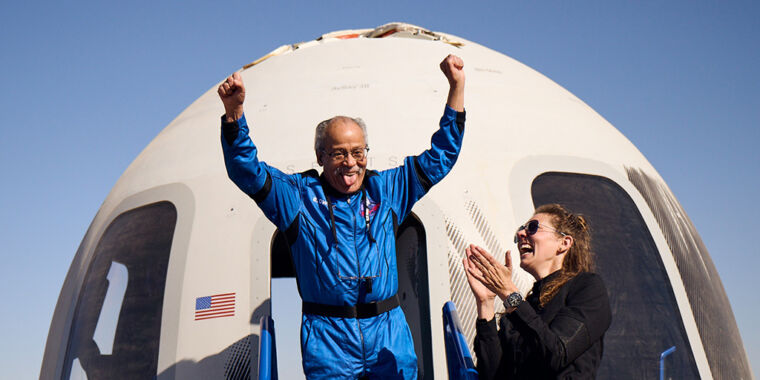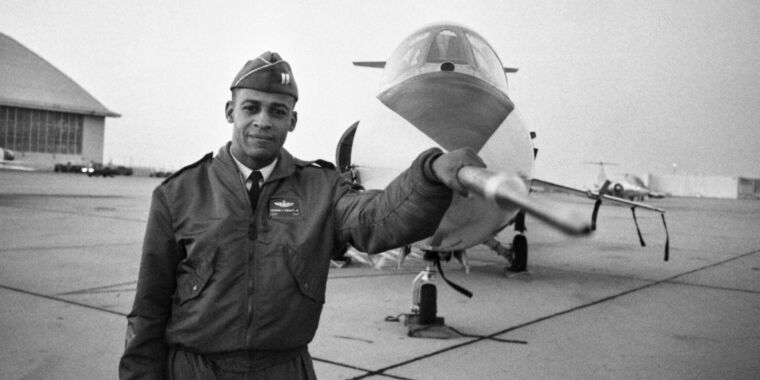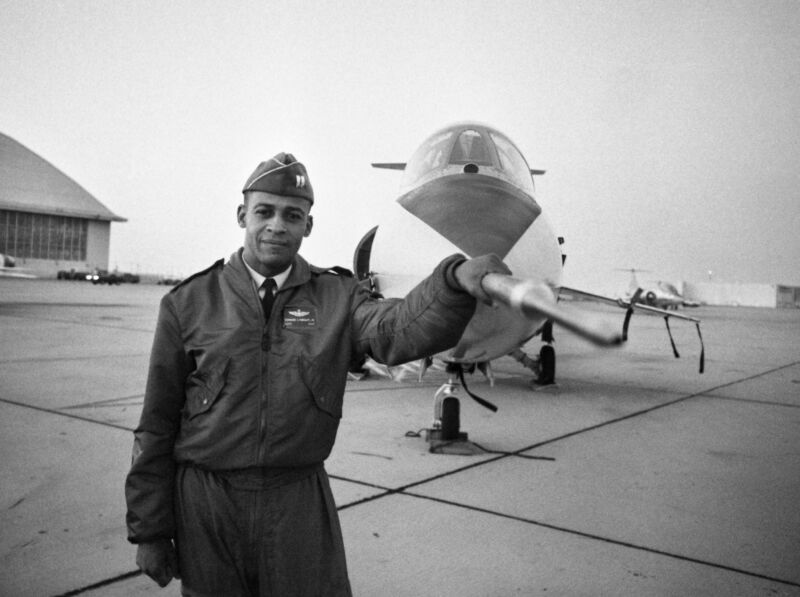Blue Origin resumes human flights to suborbital space, but it wasn’t perfect
“I lied” —
Blue Origin’s space capsule safely landed despite a problem with one of its parachutes.
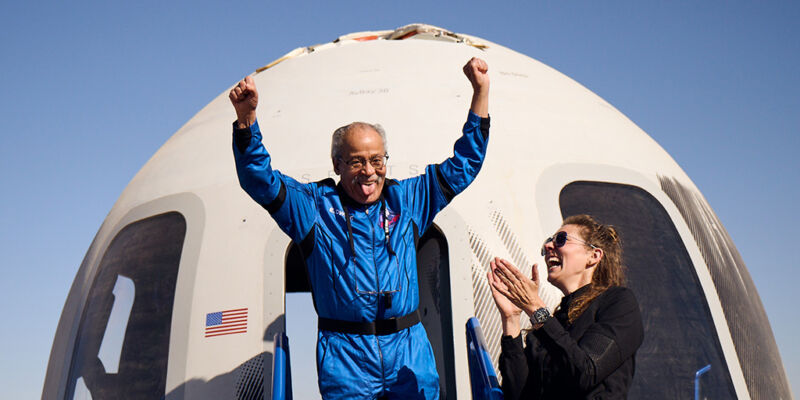
Enlarge / Ed Dwight, 90, exits Blue Origin’s crew capsule Sunday after a 10-minute flight to the edge of space.
More than 60 years after he was denied an opportunity to become America’s first Black astronaut, Ed Dwight finally traveled into space Sunday with five other passengers on a 10-minute flight inside a Blue Origin capsule.
Dwight, a retired Air Force captain and test pilot, had a chance to become the first African American astronaut. He was one of 26 pilots the Air Force recommended to NASA for the third class of astronauts in 1963, but the agency didn’t select him. It took another 20 years for America’s first Black astronaut, Guion Bluford, to fly in space in 1983.
“Everything they did, I did, and I did it well,” Dwight said in a video released by Blue Origin. “If politics had changed, I would have gone to space in some kind of capacity.”
At the age of 90, Dwight finally entered the record books Sunday, becoming the oldest person to reach space, displacing the previous record-holder, actor William Shatner, who flew on a similar Blue Origin launch to the edge of space in 2021.
“I thought I didn’t need it in my life,” Dwight said after Sunday’s fight. “But I lied!”
Since retiring from the Air Force, Dwight became an accomplished sculptor. His works, which focus on Black history, are installed at memorials and monuments across the country.
“The transitions, the separations and stuff were a little bit more dynamic than I thought,” Dwight said in remarks after Sunday’s flight. “But that’s how it’s supposed to be. It makes your mind wonder, ‘Is something wrong?’ But no, it was absolutely terrific and the view … absolutely fantastic. This was a life-changing experience. Everybody needs to do this.”
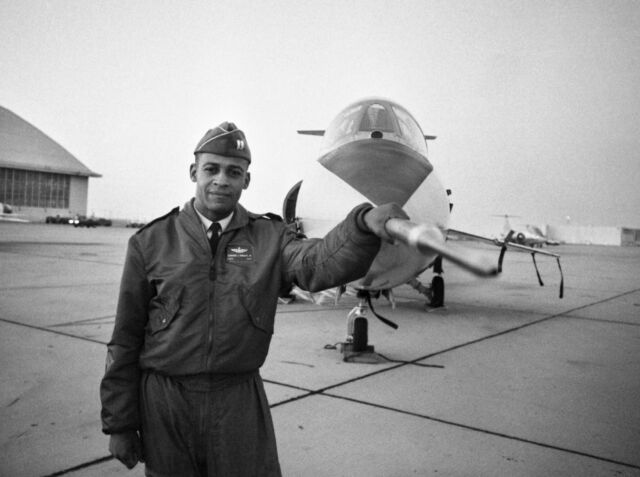
Enlarge / Ed Dwight stands in front of an F-104 jet fighter in 1963.
Dwight and his five co-passengers lifted off from Blue Origin’s remote launch site in West Texas at 9: 35 am CDT (14: 35 UTC). Strapped into reclining seats inside a pressurized capsule, the passengers rode Blue Origin’s New Shepard rocket into the uppermost layers of the atmosphere. After burning its main engine more than two minutes, the rocket released the crew capsule and continued coasting upward to an apogee, or high point, of nearly 66 miles (107 kilometers), just above the internationally recognized boundary of space.
This was the seventh time Blue Origin, the space company owned by billionaire Jeff Bezos, has flown people to suborbital space, and the 25th flight overall of the company’s fleet of New Shepard rockets. It was the first time Blue Origin has launched people in nearly two years, resuming suborbital service after a rocket failure on an uncrewed research flight in September 2022. In December, Blue Origin launched another uncrewed suborbital research mission to set the stage for the resumption of human missions Sunday.
Joining Dwight on Blue Origin’s capsule were investor Mason Angel, French businessman Sylvain Chiron, software engineer Kenneth Hess, adventurer Carol Schaller, and Gopi Thotakura, an Indian pilot and entrepreneur. Dwight’s ticket with Blue Origin was sponsored by Space for Humanity, a nonprofit that seeks to expand access to space for all people, and the other five participants were paying passengers.
After cutoff of the New Shepard rocket engine, the passengers had a few minutes to unfasten their seatbelts and float around the cabin while taking in the view of Earth. They returned to their seats as the capsule descended back into the atmosphere. The reusable New Shepard booster reignited its main engine for a propulsive landing back in Texas, while the crew capsule deployed parachutes to slow for touchdown a few miles away.
Two of three
However, one of the three main parachutes did not fully unfurl as the capsule drifted back to the ground. The capsule is designed to safely land with two chutes, a capability Blue Origin demonstrated on a test flight in 2016.
“It looks like we do have two parachutes that have full inflation, the third is not quite fully inflated,” said Ariane Cornell, a Blue Origin official hosting the company’s live webcast Sunday. “Landing with two parachutes is perfectly OK for this system.”
Family members and Blue Origin personnel greeted the passengers as they exited the capsule. All six appeared to be in good spirits and good health.
Although it had no obvious ill effects on the crew or the spacecraft, Blue Origin engineers will investigate the malfunction to determine what went wrong. The capsule’s three main parachutes were supplied to Blue Origin by Airborne Systems, which manufactures parachutes for every US human-rated spacecraft.
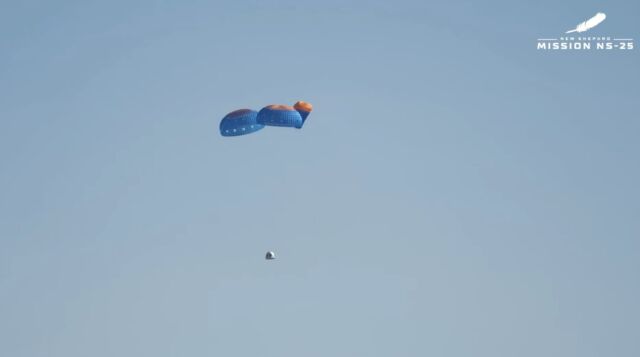
Enlarge / One of the three main parachutes on Blue Origin’s crew capsule did not fully inflate before landing.
Blue Origin
Airborne also provides parachutes for SpaceX’s Dragon spacecraft, Boeing’s Starliner, and NASA’s Orion capsule. Those parachutes have different designs and sizes than the chutes used on Blue Origin’s capsule, but it wasn’t immediately clear if there might be any crossover concerns on other programs stemming from the malfunction on Sunday’s flight.
The Federal Aviation Administration, the regulatory agency that oversees US commercial space missions, said in a statement it did not consider the parachute issue a mishap. This statement suggests the incident will not trigger a mishap investigation that would require FAA oversight.
Before the 2022 launch failure, Blue Origin’s New Shepard program achieved a cadence, on average, of roughly one flight every two months. Virgin Galactic, the space tourism company founded by Richard Branson, ramped up the flight rate of its suborbital SpaceShipTwo spaceplane over the last year as Blue Origin’s rocket remained grounded.
But Virgin Galactic is about to halt operations of its own spaceship following one more flight with passengers next month. The company says it decided to suspend flights of the VSS Unity rocket plane to focus its resources on developing a fleet of larger air-launched spaceships that are easier to reuse.
This means Blue Origin, assuming it can regain or build on the cadence it demonstrated in 2021 and 2022, will be the only company serving the suborbital space tourism and research market for at least the next couple of years.
Blue Origin resumes human flights to suborbital space, but it wasn’t perfect Read More »
